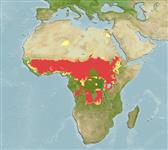Actinopterygii (ray-finned fishes) >
Perciformes (Perch-likes) >
Latidae (Lates perches)
Etymology: Lates: Latin, lateo, latere = to be hidden.
Environment / Climate / Range
Ecology
Freshwater; demersal; potamodromous (Ref. 51243); depth range 10 - 60 m (Ref. 34290). Tropical, preferred ?; 27°N - 7°S
Africa: widespread throughout the Nilo-Sudan region of Africa, occurring commonly in all major river basins including the Senegal, Niger, Volta, Chad (Ref. 81285) and Nile (Ref. 3636). Found almost everywhere in West Africa, except in Gambia (Ref. 81285). Also present in the Congo basin and lakes Albert, Turkana/Rudolph and Tana (Ref. 3636). Several countries report adverse ecological impact after introduction.
Length at first maturity / Size / Weight / Age
Maturity: Lm 74.3, range 53 - 85 cm
Max length : 200 cm TL male/unsexed; (Ref. 58490); common length : 100.0 cm SL male/unsexed; (Ref. 34290); max. published weight: 200.0 kg (Ref. 3900)
Dorsal
spines
(total): 7 - 8;
Dorsal
soft rays
(total): 8-14. Diagnosis: mouth large and protrusible, lower jaw prominent; numerous villiform teeth present in jaws and on palate (Ref. 81285). Preorbital (Ref. 4967) and preopercle denticulate (Ref. 4967, 81285). A strong opercular spine present (Ref. 4967, 81285). Caudal fin rounded (Ref. 4967, 81285). Scales ctenoid, 54-74 along lateral line, followed by 6-8 pored scales on caudal-fin base; ceratobranchial (lower limb) of first gill arch with 12-14 gill rakers (Ref. 81285).
Coloration: body uniformly silvery (Ref. 81285) or dark greyish-blue dorsally, greyish-silver on flank and ventrally (Ref. 34290). Fins greyish; interior of eye conspicuously yellowish; juveniles brownish with lighter marbling (Ref. 81285).
Inhabits channels, lakes and irrigation canals. Adults inhabit deep water, while juveniles are found in shallow water. Feeds on fish especially clupeids and Alestes (Ref. 13851); smaller fish also feed on larger crustaceans and insects. Juveniles are planktivorous (Ref. 28714). Threatened due to over harvesting (Ref. 58490). No length type given but assumed to be in TL. Maximum reported size of 180.0 cm corresponding to a weight of 164 kg in Lake Albert (Ref. 81285).
Teugels, G.G., C. Lévêque, D. Paugy and K. Traoré, 1988. État des connaissances sur la faune ichtyologique des bassins côtiers de Côte d'Ivoire et de l'ouest du Ghana. Rev. Hydrobiol. Trop. 21(3):221-237. (Ref. 272)
IUCN Red List Status (Ref. 115185)
CITES (Ref. 94142)
Not Evaluated
Threat to humans
Potential pest
Human uses
Fisheries: highly commercial; aquaculture: commercial; gamefish: yes
Tools
Special reports
Download XML
Internet sources
